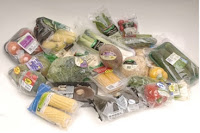I thought I would blog about some information that was a bit more positive rather than informing you of fungicides in your produce....my natural medicine cabinet! Most people are aware that there are natural alternatives out there for everyday ailments. Many of these alternatives can be found at stores like Sprouts or Whole Foods, some other grocery stores even have small areas dedicated to natural foods. Often people don't feel comfortable purchasing a bottle that has "not reviewed or approved by the FDA" printed on the side of it. The reality is how can pharmaceutical companies make money if the FDA endorsed healing herbs and food that we could all grow in our backyards on our own?!
The first record of herbs being used for medicinal purposes was over 5,000 years ago! Personally, I feel more comfortable with something that has been around longer than pharmaceutical companies. Not only have herbal remedies been around longer, they have been proven successful. It only makes sense that the human body would have a better response to plants and herbs; after all, the two have existed and evolved together. Now, I'm not a doctor by any means and I'm not telling anyone to stop using medication and replace it with a natural cure. I have just spent years of my life studying the uses and effects of herbs for medicine and can honestly tell you that I have personally used what I have listed below, and use herbal remedies for my family.
There is an abundance of herbs and plants that have healing purposes. There is even more to study and learn as far as different parts of a plant being used for different ailments and how to use it. For right now I'm going to list some more common plants that you can probably find in your kitchen.
 |
| Ginger Root |
Ginger Root- Good for stomach relief such as morning sickness, motion sickness, and several types of food poisoning. Also a circulatory remedy, helping blood flow throughout your body. It's an anti-inflammatory food, and good for soothing cough, cold, and flu. You can find ginger root in the produce section of where you shop, farmers markets, and you can even purchase ginger root tea bags.
 |
| Thyme |
Thyme- First and best known for remedy for whooping cough. Good for asthma and hay fever, especially in children. Remedy for chest infections such as bronchitis and good for overall immune system because it has antiseptic properties. If applied topically (oil form) it relieves bites, stings, athlete's foot, lice, and rheumatic pain.
 |
| Sage |
Sage- Great remedy for sore throats, digestion problems, and irregular menstruation. Studies have even shown that this herb is helpful in preventing onset of Alzheimer's. For sore throats it can be used to gargle with, it is also good for canker sores and sore gums. Helps in reducing menopausal hot flashes and aides body in adapting to hormonal changes.
 |
| Avocado |
Avocado- Aside from being super nutritious and an excellent and easy homemade baby food avocado has also been shown to help lower cholesterol levels. If applied externally it cools and soothes irritated or burned skin. Avocado oil has been used to treat skin blemishes and the pulp has been used to stimulate hair growth.
 |
| Peppermint |
Peppermint- Top of its class in relieving gas, flatulence, bloating, and colic by relaxing those stomach muscles. It relieves constipation and diarrhea. Peppermint oil makes a great chest rub for respiratory infections or colds. The oil is also good for migraines, headaches, and eczema. Peppermint tea is also great for congestion and tastes yummy.
 |
| Garlic |
Garlic- Is an antibiotic plant making it a very powerful treatment for many health issues. It can counter many infections, anything to do with nose, throat, and chest. Helps with cholesterol, problems with circulation, high blood pressure, blood sugar levels, protects against blood clots. Treats ear infections, flu, and urinary infections. Personally I make garlic tea whenever myself or family is starting to get sick. Crush or chop about 7 garlic cloves and boil for at least 30 minutes. Don't worry after all that boiling it tastes nothing like garlic!
Again, these are just a very few of the plants that can be used as medicine. There are many many more. I just wanted to give some insight to some common ones that most people would likely have in their homes. If you have questions about other herbs and plants please feel free to visit my website and contact me.











